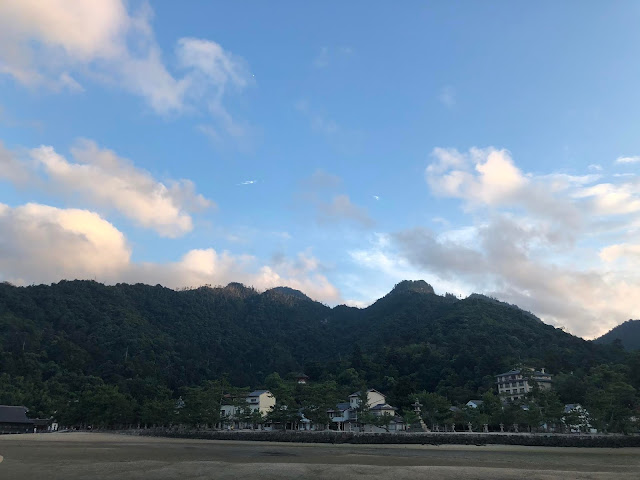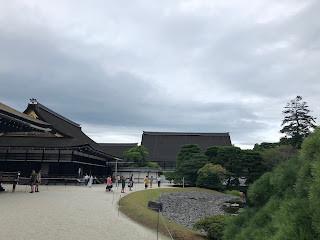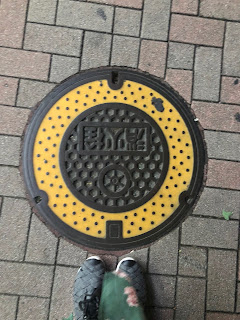In this blog, I'll share my travel experience in Japan and a bit about all the places I visited as well as the ones I missed.
If you are planning a trip to Japan, probably my little write up would come to some use!
First things first! Lemme warn you that this is gonna be a long read. Get yourself a cuppa coffee/tea and settle in.
Japan is massive and beautiful. If you wish to make a trip, ensure that you plan at least for 15 days.
Either that or you stick to visiting only 1-2 places and make the best of it. Else you don't really get to enjoy the place and its vibe.
Also be prepared to walk- a lot! You end up walking easily about 10 km a day on an average! So ditch those fancy footwear and opt for a good pair of walking shoes. (Trust me you will thank me for this tip!)
Lets talk about the weather next. 4 seasons that are quite prominent are:
- Spring (March to May)- The season of Sakura flowers or popularly known as the cherry blossoms. It is the busiest and the most expensive time to visit japan. For those who dont mind splurging a bit to enjoy the beauty of spring, then march to may is the time to be!
- Summer (June to August)- This is by far the hottest phase of Japan. Humid and sultry with one off showers is what you can expect around this time.
- Autumn (September to November)- The time of the year when leaves turn to golden then orange and finally a beautiful deep red before falling off. Typhoons and showers are quite common in September (Trust me! we just missed a massive one by a few hours and gods blessings!!) October and November tends to get colder ushering in Winter.
- Winter (December to February)- The white season! The northern island of Hokkaido, Mount Fuji and much of the Japanese Sea coast get a lot of snow. The rest of the mainland gets little snow, and average temperatures around 1-5°C. But the weather is usually clear, crisp and pleasant, not damp.
The southern part of the country is comparatively warmer than the northern part. So you can pack your clothing according to the places you would be visiting.
Talking about packing, ensure that you travel light. Airplanes & Taxis are an extremely expensive mode of commute plus Japan is known for its rail system and punctuality. So the best mode of transport without doubt is the rail system and lugging around heavy suitcases can be quite cumbersome when you have to run from one platform to another.
They have long distance high speed trains, regular local trains, trams, buses and even ferries for commute.
JR is the most popular railway group.
One thing that you have to do if you have a trip planned to Japan is to buy the JR Pass (Japan Rail Pass)
What is a Rail Pass you may ask.
Japan Rail Pass is a multi-use all you can ride discounted ticket, valid for travels on all JR national trains in Japan, including Shinkansen bullet trains and Narita Express as well as JR bus services, ferry services, and airport transfers. You can select 7, 14 or 21 consecutive validity days. You have the option to choose between Standard and Green Car (first class) based on your budget.
This facility is available only for tourists who visit Japan and trust me this is the best decision we took for our journey because ,lets face it, Japan is a very expensive place and literally everything there is expensive except for Alcohol (which I felt is cheaper than Dubai and India)!
This rail pass saves you a lot of money as buying individual tickets for train travel can cause quite a dent in your bank account. Plus this is unlimited usage! If you avail a 7 day pass, you can use it as frequently as you wish on any of the JR trains/buses/ferries over the 7 days.
There are lots of companies offering Japan Rail passes but after doing a lot of research, I found the best one on this website : https://www.jrailpass.com/
Check out the website for further details.
Am not marketing here but this website is authentic and you get your money's worth! We sure did!!
Ours was a short 9 day trip covering 3 main places- Tokyo, Hiroshima & Kyoto.
As luck my have it, we decided to do our journey anti clockwise.
Although we arrived in Tokyo, we chose to do Hiroshima the very next day itself and proceed to Kyoto and there on back to Tokyo and take our flight back. This was the wisest move of our lives as otherwise, we would have got engulfed or stranded by Typhoon Jebi which apparently was the strongest typhoon to hit Japan since 1993!
So arriving at Narita airport, we exchanged the JR voucher for our actual rail pass.
After an overnight stay in Tokyo, we started for Hiroshima on the legendary Shinkansen aka the bullet train.
It sure was an experience of a lifetime!
We had taken the Green Class car pass which has the option of availing reserved tickets. So at the rail station, we got reserved tickets from the ticketing counter.
The seats on both the regular and green class can be rotated. So if you are travelling with friends, you can rotate your seats to face each other and travel (which we intend to do on our next trip to Japan when we find the right travel buddies)
A journey of 810km was easily covered by the bullet train in less than 4 hours!The maximum operating speed of the train is 320kmph!
We chose to stick to the tradition and opted the Ekiben for lunch which is the traditional railway boxed meals (Bento) available at train stations and trains in Japan.
Talking about food I must say that Japanese food is exquisite! It is so much beyond sushis and sahimis. Each part of Japan is popular for their specialty.
From japanese omelettes to yakisobas to takoyakis to Okinomayakis to soba noodles to donburis to ramens to yakitoris to miso to shabu shabu to kobe beef to Kare raise which is curry rice.The options are plenty. Yes you read it right. Curry is a very popular and favoured Japanese dish (almost all of them love it. It is inspired by the Indian curry).
But I must warn you that they are a meat loving folk. By meat I mean pork. That's the most preferred meat of them all.Although I must admit that these folk eat almost everything from the sea (sparing snakes n insects) and every park of the chicken sparing the feathers!!
So if you are someone who doesn't eat pork (like me) then you are in for some surprise. Also be prepared to say "Butaniku nashi" which translated to- no pork.
I will write a separate blog just on the food & beverages!
After reaching Hiroshima, we opted to take the bus (which was a part of the JR pass) to our hotel.
We chose to spend the rest of the day exploring the city and the nightlife.
Hiroshima has 2 faces- calm, peaceful and quiet during the day and insanely buzzing and active during the night.
Next day we set out to Miyajima also known as Itsukushima. It is a small island in Hiroshima Bay, western Japan. It is known for its forests, Mount Misen, museum, aquarium, deer park and a couple of ancient temples. Just offshore, the giant, orange Great Torii Gate is partially submerged at high tide.It is also known as the floating Torii gate due to this. It marks the entrance to the Itsukushima Shrine, which was first built in the 12th century.
During low tide you can even walk up the gate and touch it.
Nearby, the Museum of History and Folklore has cultural artifacts in a 19th-century merchant's home.
To reach Miyajima, you have to take to train to the Miyajima station and there on travel to the island by ferry.
The deer here are very friendly. I must warn you that they are also very hungry. If they see you carrying any shopping bags or open bags, they are sure to go through it and take whatever they find interesting. My suggestion would be to avoid plastics in any form and instead carry a good backpack so that you can store things even if you are to shop there.
The artifact and souvenir shops have a lot to offer and are extremely hard to resist :)
The next place of interest is the Carp Castle,was the home of the daimyō (a feudal lord). The castle was constructed in the 1590s, but was destroyed by the atomic bombing on August 6, 1945. It was rebuilt in 1958, a replica of the original that now serves as a museum of Hiroshima's history before World War II.
You will find such beautiful Palaces and temples all across Japan.
After the castle, we headed to the Hiroshima Peace Dome & garden or rather what remains after the bombing. It is a heart wrenching site.
Although the park is beautiful, it is extremely depressing to see what the atomic bomb has done to the place.
Post that we went to the Gion side to see Geishas in real! We went to Gion Corner for a show which had a mix of the traditional Japanese theatre performance, Geisha performance,tea ceremony as well as bunraku which is the traditional puppet show.
Here is a little exert from Wikipedia on Japanese Geishas
Kyoto has the perfect mix of culture and modern city life.
On one side you have the traditional castles, temples, tea ceremonies and the like while on the other end there is a vibrant city with a night life that never sleeps!
We had stayed in the heart of the city and so restaurants and clubs were all within walking distance.
Japan is known for its alleys which has rows and rows of restaurants or pubs depending on the area.
Areas are divided basis that. Some areas are mainly for shopping while some for restaurants n some for the pubs and clubs..
Next day we set out to the renowned Arashiyama or the bamboo forest.Arashiyama is the second-most important sightseeing district in Kyoto. It’s filled with temples and shrines, but the star attraction is the famed Arashiyama Bamboo Grove.
After the castle, we headed to the Hiroshima Peace Dome & garden or rather what remains after the bombing. It is a heart wrenching site.
Although the park is beautiful, it is extremely depressing to see what the atomic bomb has done to the place.
There on we headed to Kyoto by the Shinkansen.
Kyoto is a beautiful place and holds a special place in my heart.
When in Kyoto, you must do a traditional Japanese tea ceremony.
Japan takes its tea seriously. The Japanese tea ceremony, also called the Way of Tea, is a Japanese cultural activity involving the ceremonial preparation and presentation of matcha, powdered green tea.
In Japanese, it is called chanoyu or sadō, chadō , while the manner in which it is performed, or the art of its performance, is called temae .Zen Buddhism was a primary influence in the development of the Japanese tea ceremony. Much less commonly, Japanese tea practice uses leaf tea, primarily sencha, in which case it is known in Japanese as senchadō (the way of sencha) as opposed to chanoyu or chadō.
There are tea houses where you can prebook for a tea ceremony. We visited the Tondaya Tea House which is 150 years old. Tondaya is a kimono wholesaler by Tanaka family for generations. So you can buy good quality kimonos from here..
Here is a little exert from Wikipedia on Japanese Geishas
| Geisha | |||
|---|---|---|---|
 | |||
| Japanese name | |||
| Kanji | 芸者 | ||
| |||
Geisha (芸者) or geigi (芸妓) are traditional female Japanese entertainers. They are skilled at different Japanese arts, like playing classical Japanese music, dancing and poetry. Some people believe that geisha are prostitutes, this however is false.[1] The term "geisha" is made of two Japanese words, 芸 (gei) meaning "art" and 者 (sha) meaning "person who does" or "to be employed in". The most literal translation of geisha to English is "artist". Geisha are very respected and it is hard to become one.
Kyoto has the perfect mix of culture and modern city life.
On one side you have the traditional castles, temples, tea ceremonies and the like while on the other end there is a vibrant city with a night life that never sleeps!
We had stayed in the heart of the city and so restaurants and clubs were all within walking distance.
Japan is known for its alleys which has rows and rows of restaurants or pubs depending on the area.
Areas are divided basis that. Some areas are mainly for shopping while some for restaurants n some for the pubs and clubs..
Next day we set out to the renowned Arashiyama or the bamboo forest.Arashiyama is the second-most important sightseeing district in Kyoto. It’s filled with temples and shrines, but the star attraction is the famed Arashiyama Bamboo Grove.
Tenryu-ji Temple is the headline attraction in Arashiyama, a sprawling Zen temple with one of the finest gardens in Kyoto and wonderful mountain views
There is also the monkey park or the Kameyama-koen Park where you get to mingle with friendly monkeys and feed them during their feeding time.
Okochi-Sanso Villa is one of the top sights in Kyoto. The gardens are worth mention here!
Rakushisha Poet’s Hut-This quaint hermit’s cottage was once the home of one of haiku master Matsuo Basho’s disciples. It’s a good palate cleanser between the area temples.
There is lots to do here in this area and you need a good day to spend.
The road is uphill and so be prepared to walk/hike a bit!
Another must visit is the Imperial Palace in Kyoto.
used to be the residence of Japan's Imperial Family until 1868, when the emperor and capital were moved from Kyoto to Tokyo. It is located in the spacious Kyoto Imperial Park.
It has beautiful zen gardens that is sure to calm and soothe the senses.
Ensure you have a whole day to spare to see this as the palace complex is humongous!
Pictures dont do justice to this beautiful place!
We visited a couple of beautiful temples like the kinaku-ji, ginkaku-ji and nanzen-ji there in kyoto!
They were all breathtakingly beautiful.
Due to time constraints we could not go to the ryoan-ji temple or many other such beautiful places.
With the Typhoon headed our way, we had to leave for Tokyo soon.
By god's grace, we missed the typhoon by a yard. Within hours of our departure from Kyoto, the typhoon hit the beautiful place and caused quite a bit of damage!
The whole Japan trip was cut short due to Jebi (thats what the typhoon was named)
Tokyo is adorned the title of one of the most exciting (and expensive) cities in the world.
The Shibuya station is supposed to be the busiest station in the world.
Tokyo is great for tax free shopping with many outlets offering tax free rates for shoppers as long as you provide your passport. Note that the tax is very high in Japan (around 30%) and is applicable on almost all commodities.
A fun and colourful district of Tokyo called Harajuku is well known for its unique street fashion.
Top runway fashion designers take inspiration from Harajuku.
A vending machine is available every 12m and you can have anything ranging from cheap sodas and candies to used underwear! Now that’s quite a deal.
Tokyo is also known for its seafood market which is the busiest in the world.
Tokyo Tower is actually the 13 meters taller than the Eiffel Tower. Although Tokyo Tower is taller than the Eiffel Tower, the advances in steel technology make it almost half its weight.
Well I guess enough said. You know what am talking about now!
For me, Tokyo is also special for the beautiful manhole covers.
Here are a few:
Japan is also known for its electronics.
Akihabara is a part of Tokyo which is also known as the electronics district!
Almost every shop there is an Electronics store.
There is a giant shopping complex called yodobashi camera complex which has about 6 humongous floors filled with literally everything under the sun!
You can easily spend a whole day there. Thats exactly what we did! Stayed as close to closing time as possible and shopped to what we could afford and returned to get a good nights sleep before catching our flight the next day.
We left Japan with a heavy heart and some heavy suitcases 😝
Given an option, I wont think twice to make my next visit to Japan. Next visit to Osaka, yokohama, nara and the like with just a small backpack. Can always buy suitcases and load it there, for we have Uniqlo which is the best for travellers. Affordable good quality clothing (which comes in sizes more than the miniature sizes one finds in other Japanese stores) and there are many shops like Daiso where I am the happiest in!

















































